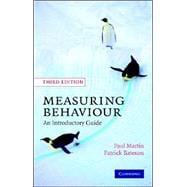
Note: Supplemental materials are not guaranteed with Rental or Used book purchases.
Purchase Benefits
What is included with this book?
| Preface | p. ix |
| Introduction | p. 1 |
| The scope of this book | p. 1 |
| The four problems | p. 2 |
| Different approaches to studying behaviour | p. 4 |
| Why measure behaviour? | p. 6 |
| Summary | p. 9 |
| Think before you measure | p. 10 |
| Choosing the level of analysis | p. 10 |
| Choosing the species | p. 11 |
| Choosing where to study | p. 11 |
| Choosing when to observe | p. 15 |
| Effects of the observer on the subject | p. 17 |
| Anthropomorphism | p. 18 |
| Ethical considerations | p. 20 |
| Summary | p. 23 |
| Getting started | p. 25 |
| The steps involved in studying behaviour | p. 25 |
| Preliminary observation | p. 31 |
| Describing behaviour | p. 32 |
| Choosing categories | p. 33 |
| Defining categories | p. 35 |
| Types of measure | p. 36 |
| Events and states | p. 39 |
| The different levels of measurement | p. 40 |
| Summary | p. 41 |
| Individuals and groups | p. 42 |
| Identifying individuals | p. 42 |
| Individual differences | p. 44 |
| Assessing individual distinctiveness | p. 45 |
| Defining a group | p. 46 |
| Summary | p. 47 |
| Recording methods | p. 48 |
| Sampling rules | p. 48 |
| Recording rules | p. 51 |
| Continuous recording | p. 52 |
| Instantaneous sampling | p. 53 |
| One-zero sampling | p. 54 |
| Choosing the sample interval | p. 55 |
| The disadavantages and advantages of time sampling | p. 57 |
| Summary | p. 60 |
| The recording medium | p. 62 |
| The options available | p. 62 |
| Check sheets | p. 65 |
| Event recorders | p. 67 |
| Summary | p. 70 |
| How good are your measures? | p. 72 |
| Reliability versus validity | p. 72 |
| Within-observer versus between-observer reliability | p. 74 |
| Measuring reliability using correlations | p. 76 |
| How reliable is reliable? | p. 78 |
| Other ways of measuring reliability | p. 78 |
| Factors affecting reliability | p. 80 |
| Dealing with unreliable measures | p. 81 |
| How independent are the measures? | p. 82 |
| Summary | p. 85 |
| How good is your research design? | p. 86 |
| Performing experiments | p. 86 |
| Experimental design | p. 87 |
| Studying development | p. 92 |
| Tests of preference and differential responsiveness | p. 97 |
| Composite measures | p. 100 |
| How much information to collect? | p. 101 |
| Summary | p. 102 |
| Statistical analysis | p. 103 |
| General advice on statistics | p. 103 |
| Spreadsheets and databases | p. 104 |
| Exploratory versus confirmatory analysis | p. 105 |
| What statistical tests should be used? | p. 107 |
| Analysis of variance (ANOVA) | p. 109 |
| Correlation | p. 110 |
| Simple regression | p. 112 |
| General linear models (GLMs) | p. 114 |
| Multivariate statistics | p. 115 |
| Circular statistics | p. 118 |
| Did you collect enough data? | p. 119 |
| Summary | p. 119 |
| Analysing specific aspects of behaviour | p. 121 |
| Bout length | p. 121 |
| Analysing sequences | p. 122 |
| Analysing rhythms | p. 125 |
| Choice tests | p. 127 |
| Social behaviour | p. 129 |
| Summary | p. 134 |
| Interpreting and presenting findings | p. 135 |
| Floor and ceiling effects | p. 135 |
| Assessing significance | p. 136 |
| Problems with correlations | p. 138 |
| Treasuring your exceptions | p. 142 |
| Prior knowledge and Bayes' theorem | p. 143 |
| Modelling | p. 144 |
| Presentation of findings | p. 146 |
| Science and the public interest | p. 150 |
| Summary | p. 151 |
| Units of measurement | p. 153 |
| Some statistical terms | p. 155 |
| Advice on statistics textbooks | p. 160 |
| Checklist to consult before publication | p. 163 |
| References | p. 165 |
| Index | p. 171 |
| Table of Contents provided by Ingram. All Rights Reserved. |
The New copy of this book will include any supplemental materials advertised. Please check the title of the book to determine if it should include any access cards, study guides, lab manuals, CDs, etc.
The Used, Rental and eBook copies of this book are not guaranteed to include any supplemental materials. Typically, only the book itself is included. This is true even if the title states it includes any access cards, study guides, lab manuals, CDs, etc.